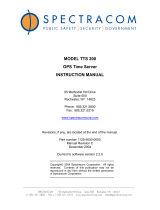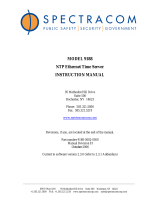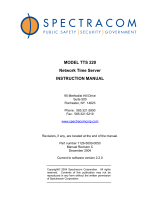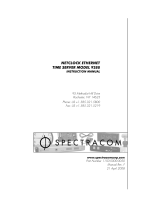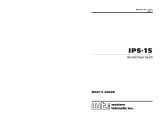Page is loading ...

MODEL 9189
NetClock/NTP Network Time Provider
INSTRUCTION MANUAL
95 Methodist Hill Drive
Suite 500
Rochester, NY 14623
Phone: 585.321.5800
Fax: 585.321.5219
www.spectracomcorp.com
Revisions, if any, are located at the end of the manual.
Part number 1109-5001-5001
Manual Revision J
October 2006
Current to software version 2.3.0 (refer to 2.3.1 Addendum)
SPECTRACOM 95 Methodist Hill Drive Suite 500 Rochester, NY 14623
+1.585.321.5800 FAX: +1.585.321.5218 www.spectracomcorp.com sa[email protected]

Copyright © 2005 Spectracom Corporation. Contents of this publication may
not be reproduced in any form without the written permission of Spectracom
Corporation. Specifications subject to change or improvement without notice.
Printed in USA.
Spectracom, NetClock, TimeView and Legally Traceable Time are Spectracom
registered trademarks. All other products are identified by trademarks of their
respective companies or organizations. All rights reserved.

SPECTRACOM 5-YEAR WARRANTY
LIMITED WARRANTY
Spectracom warrants each new product manufactured and sold by
it to be free from defects in software, material, workmanship, and
construction, except for batteries, fuses, or other material normally
consumed in operation that may be contained therein AND AS
NOTED BELOW, for five years after shipment to the original
purchaser (which period is referred to as the “warranty period”).
This warranty shall not apply if the product is used contrary to the
instructions in its manual or is otherwise subjected to misuse,
abnormal operations, accident, lightning or transient surge, repairs
or modifications not performed by Spectracom.
The GPS receiver is warranted for one year from
date of shipment and subject to the exceptions listed
above. The power adaptor, if supplied, is warranted
for one year from date of shipment and subject to
the exceptions listed above.
THE ANALOG CLOCKS ARE WARRANTED FOR ONE YEAR
FROM DATE OF SHIPMENT AND SUBJECT TO THE EXCEPTIONS
LISTED ABOVE.
THE TIMECODE READER/GENERATORS ARE WARRANTED FOR
ONE YEAR FROM DATE OF SHIPMENT AND SUBJECT TO THE
EXCEPTIONS LISTED ABOVE.
The Rubidium oscillator, if supplied, is warranted for two years from
date of shipment and subject to the exceptions listed above.
All other items and pieces of equipment not specified above,
including the antenna unit, antenna surge suppressor and antenna
pre-amplifier are warranted for 5 years, subject to the exceptions
listed above.
WARRANTY CLAIMS
Spectracom’s obligation under this warranty is limited to in-factory
service and repair, at Spectracom’s option, of the product or the
component thereof, which is found to be defective. If in
Spectracom’s judgment the defective condition in a Spectracom
product is for a cause listed above for which Spectracom is not
responsible, Spectracom will make the repairs or replacement of
components and charge its then current price, which buyer agrees
to pay.
Spectracom shall not have any warranty obligations if the
procedure for warranty claims is not followed. Users must notify
Spectracom of the claim with full information as to the claimed
defect. Spectracom products shall not be returned unless a return
authorization number is issued by Spectracom.
Spectracom products must be returned with the description of the
claimed defect and identification of the individual to be contacted
if additional information is needed. Spectracom products must be
returned properly packed with transportation charges prepaid.
Shipping expense: Expenses incurred for shipping Spectracom
products to and from Spectracom (including international customs
fees) shall be paid for by the customer, with the following
exception. For customers located within the United States, any
product repaired by Spectracom under a “warranty repair” will be
shipped back to the customer at Spectracom’s expense unless
special/faster delivery is requested by customer.
Spectracom highly recommends that prior to returning equipment for
service work, our technical support department be contacted to
provide troubleshooting assistance while the equipment is still
installed. If equipment is returned without first contacting the
support department and “no problems are found” during the repair
work, an evaluation fee may be charged.
EXCEPT FOR THE LIMITED WARRANTY STATED ABOVE,
SPECTRACOM DISCLAIMS ALL WARRANTIES OF ANY KIND
WITH REGARD TO SPECTRACOM PRODUCTS OR OTHER
MATERIALS PROVIDED BY SPECTRACOM, INCLUDING
WITHOUT LIMITATION ANY IMPLIED WARRANTY OR
MERCHANTABILITY OR FITNESS FOR A PARTICULAR PURPOSE.
Spectracom shall have no liability or responsibility to the original
customer or any other party with respect to any liability, loss, or
damage caused directly or indirectly by an Spectracom product,
material, or software sold or provided by Spectracom, replacement
parts or units, or services provided, including but not limited to any
interruption of service, excess charges resulting from malfunctions of
hardware or software, loss of business or anticipatory profits
resulting from the use or operation of the Spectracom product or
software, whatsoever or howsoever caused. In no event shall
Spectracom be liable for any direct, indirect, special or
consequential damages whether the claims are grounded in
contract, tort (including negligence), or strict liability.
EXTENDED WARRANTY COVERAGE
Extended warranties can be purchased for additional periods
beyond the standard five-year warranty. Contact Spectracom no
later than the last year of the standard five-year warranty for
extended coverage.
SPECTRACOM 95 Methodist Hill Drive Suite 500 Rochester, NY 14623
+1.585.321.5800 FAX: +1.585.321.5218 www.spectracomcorp.com sa[email protected]

Table of Contents
1 GENERAL INFORMATION...........................................................................................1-1
1.1 Introduction................................................................................................................1-1
1.2 Warranty Information and Product Support .........................................................1-2
1.3 Unpacking...................................................................................................................1-3
1.3.1 Package Contents.....................................................................................................1-3
1.4 Model 9189 Specifications.........................................................................................1-4
1.4.1 Receiver ...................................................................................................................1-4
1.4.2 RS-232 Setup Port....................................................................................................1-4
1.4.3 10/100 Ethernet Port................................................................................................1-4
1.4.4 Protocols supported..................................................................................................1-4
1.4.5 RS-232 Communication Port (1 by default or 2 if Option 2 is installed)................1-5
1.4.6 RS-485 Output (2)....................................................................................................1-5
1.4.7 Front Panel Display (Applicable only to units with Option 2 installed)..................1-6
1.4.8 Front Panel LED Indicators.....................................................................................1-6
1.4.9 Relay Outputs...........................................................................................................1-6
1.4.10 Input Power..............................................................................................................1-7
1.4.11 Mechanical and Environmental ...............................................................................1-7
1.4.12 Agency Approvals ...................................................................................................1-7
2 INSTALLATION...............................................................................................................2-1
2.1 Installation Summary................................................................................................2-1
2.2 Tools and cables required .........................................................................................2-3
2.3 Power and Ground Connection................................................................................2-3
2.4 GPS Antenna Installation..........................................................................................2-4
2.4.1 Antenna Cable for Outdoor Antenna.......................................................................2-4
2.4.2 Cable Lengths ..........................................................................................................2-4
2.4.3 Model 8224 GPS splitter..........................................................................................2-5
2.4.4 Model 8226 Impulse Suppressor .............................................................................2-5
2.4.5 Model 8227 GPS Inline Amplifier...........................................................................2-6
2.5 Ethernet Network Cabling........................................................................................2-7
2.5.1 Optional CNC3000 cable kit:...................................................................................2-7
2.6 Remote port and Serial comm port output pin-outs and wiring...........................2-8
2.6.1 Serial Comm port.....................................................................................................2-8
2.6.2 Remote RS-485 port connections ............................................................................2-9
2.6.3 Remote Output Usage............................................................................................2-10

2.6.4 RS-485 Guidelines.................................................................................................2-10
2.6.5 Connection Method................................................................................................2-11
2.6.6 Termination............................................................................................................2-16
3 PRODUCT CONFIGURATION......................................................................................3-1
3.1 Network Configuration .............................................................................................3-1
3.1.1 To configure the product to work on a network via the Setup port.........................3-2
3.1.2 To configure the product to work on a network via the web browser user interface 3-
4
3.1.3 Default and Recommended Configurations.............................................................3-6
3.2 Login............................................................................................................................3-7
3.2.1 To Change the Default Login Password Values....................................................3-10
3.2.2 To reset the current Login Password Values back to the factory default values...3-11
3.3 Alarms.......................................................................................................................3-12
3.3.1 Alarm Outputs........................................................................................................3-12
3.3.2 Alarm log...............................................................................................................3-12
3.4 Event Timer..............................................................................................................3-14
3.4.1 Configuring the Event Time ..................................................................................3-14
3.5 GPS Operation.........................................................................................................3-18
3.5.1 How to set up the GPS receiver.............................................................................3-18
3.5.2 Set System Mode ...................................................................................................3-19
3.6 GPS Signal Status ....................................................................................................3-21
3.7 Local System Clocks Setup .....................................................................................3-26
3.7.1 Time Zone and DST...............................................................................................3-29
3.8 Interface Setup.........................................................................................................3-33
3.8.1 Configuration parameters for the Remote and Serial Interfaces............................3-33
3.8.2 To configure a product's Interface via web browser user interface.......................3-33
3.9 Logs ...........................................................................................................................3-35
3.9.1 Display Alarm Log ................................................................................................3-36
3.9.2 Display Dial-Out Log (Option 3 – Modem)..........................................................3-37
3.9.3 Display Event Relay Log.......................................................................................3-40
3.9.4 GPS Qualification Log...........................................................................................3-41
3.9.5 Display Operational Log........................................................................................3-42
3.10 “Set To Defaults” web browser user interface......................................................3-44
3.11 NTP/SNTP................................................................................................................3-45
3.11.1 Configure NTP.......................................................................................................3-45
3.11.2 NTP Support ..........................................................................................................3-47

3.11.3 Application Note: MD5 Authentication using a Cisco Router.............................3-47
3.12 NTP Statistics...........................................................................................................3-49
3.13 Relays........................................................................................................................3-52
3.13.1 Configuring the relays............................................................................................3-52
3.14 SNMP........................................................................................................................3-54
3.14.1 SNMP Configuration.............................................................................................3-54
3.14.2 Spectracom MIB....................................................................................................3-59
3.14.3 SNMP Support.......................................................................................................3-59
3.15 System Status............................................................................................................3-60
3.15.1 Dynamic System Information................................................................................3-60
3.15.2 Static System Information......................................................................................3-61
3.15.3 System Test Results...............................................................................................3-61
3.15.4 System Features and Options.................................................................................3-62
3.16 System Time .............................................................................................................3-64
3.17 Variable Holdover....................................................................................................3-66
3.17.1 Setting the variable holdover value for the oscillator............................................3-67
4 OPERATION .....................................................................................................................4-1
4.1 Front Panel.................................................................................................................4-1
4.1.1 Status Indicator ........................................................................................................4-3
4.2 Rear Panel...................................................................................................................4-4
4.3 Leap Second occurrence............................................................................................4-6
4.3.1 Reasons for a Leap Second correction.....................................................................4-6
4.3.2 Leap Second alert notification.................................................................................4-6
4.3.3 Sequence of a Leap Second correction being applied .............................................4-7
5 TROUBLESHOOTING....................................................................................................5-1
5.1 Front Panel Power and Sync Lamps........................................................................5-1
5.2 Front Panel LAN Connector.....................................................................................5-2
5.3 Verify operation of a Serial port...............................................................................5-3
5.4 Verify operation of a Spectracom TimeTap............................................................5-3
5.5 GPS reception.............................................................................................................5-3
5.5.1 No GPS Reception...................................................................................................5-4
5.5.2 Low GPS Quality.....................................................................................................5-4

5.6 Modem Dial-out (Option 3) troubleshooting...........................................................5-6
5.6.1 Test 1: To verify modem is dialing and connecting to NIST in stand-alone mode: 5-6
5.6.2 Test 2: Verify operation of the modem operation while connected to the Spectracom
Master Clock........................................................................................................5-8
5.7 Customer Service.......................................................................................................5-9
6 SERIAL DATA FORMATS .............................................................................................6-1
6.1.1 Format 0:..................................................................................................................6-1
6.1.2 Format 1:..................................................................................................................6-3
6.1.3 Format 2:..................................................................................................................6-5
6.1.4 Format 3:..................................................................................................................6-7
6.1.5 Format 4:..................................................................................................................6-9
6.1.6 Format 7:................................................................................................................6-10
6.1.7 Format 8:................................................................................................................6-12
6.1.8 Format 90:..............................................................................................................6-13
7 RS-232 SETUP PORT COMMANDS..............................................................................7-1
7.1 fpd................................................................................................................................7-2
7.2 help..............................................................................................................................7-4
7.3 login.............................................................................................................................7-5
7.4 logout...........................................................................................................................7-6
7.5 ltc.................................................................................................................................7-7
7.6 mdo..............................................................................................................................7-8
7.7 mdo help <enter>.......................................................................................................7-8
7.8 mdo avg <on|off> <#|auto> <enter>.........................................................................7-8
7.9 mdo log <normal|debug> <enter>............................................................................7-8
7.10 mdo stat [reset] <enter> ............................................................................................7-8
7.11 net................................................................................................................................7-9
7.12 net gateway.................................................................................................................7-9
7.13 net help......................................................................................................................7-11
7.14 net ip..........................................................................................................................7-11
7.15 net mac......................................................................................................................7-12

7.16 net mask....................................................................................................................7-13
7.17 net show.....................................................................................................................7-13
7.18 net http......................................................................................................................7-14
7.19 opt..............................................................................................................................7-16
7.20 reboot [bootloader] ..................................................................................................7-17
7.21 rem.............................................................................................................................7-18
7.22 sec ..............................................................................................................................7-19
7.23 sec help......................................................................................................................7-20
7.24 sec level......................................................................................................................7-21
7.25 sec password.............................................................................................................7-21
7.26 ser ..............................................................................................................................7-22
7.27 update........................................................................................................................7-23
7.28 update app ................................................................................................................7-23
7.29 update boot...............................................................................................................7-25
7.30 update csl ..................................................................................................................7-26
7.31 update kern...............................................................................................................7-27
7.32 update help ...............................................................................................................7-27
8 OPTIONS............................................................................................................................8-1
8.1 Option 1: Security......................................................................................................8-2
8.1.1 Option 1 basics.........................................................................................................8-2
8.1.2 Security overview ....................................................................................................8-2
8.1.3 Configuring SSH......................................................................................................8-2
8.1.4 Managing Host Keys................................................................................................8-3
8.1.5 Configuring HTTPS...............................................................................................8-12
8.1.6 Deleting Certificates, Private Keys, and Certificate Requests...............................8-12
8.1.7 Restoring Self Signed Certificates and Private Keys.............................................8-13
8.1.8 Creating Self Signed Certificates, a Private Key, and a Certificate Request.........8-14
8.1.9 Requesting Certificate Authority Certificates........................................................8-16
8.1.10 Installing Certificates.............................................................................................8-17
8.1.11 Using Externally generated Certificates................................................................8-18
8.1.12 What to do if you cannot get into a secure Spectracom Product...........................8-19

8.2 Option 2: Front Panel Display................................................................................8-20
8.2.1 Using the web browser user interface to configure the Front Panel Display: .......8-20
8.3 Option 3: Modem.....................................................................................................8-23
8.3.1 Option 3 basics.......................................................................................................8-23
8.3.2 Modem installation................................................................................................8-23
8.3.3 Modem Dial-Out Setup..........................................................................................8-23
8.3.4 Calibration Call......................................................................................................8-24
8.3.5 Time Verification Call...........................................................................................8-24
8.3.6 Time Sync Call ......................................................................................................8-24
8.3.7 Modem Test Call....................................................................................................8-24
8.3.8 Modem Dial-Out CONFIGURE page ...................................................................8-25
8.3.9 Modem Dial-out DIALOUT page .........................................................................8-27
8.3.10 Modem Dial-out CALIBRATE page.....................................................................8-30
8.3.11 Modem Dial-out TEST page..................................................................................8-32
9 SW LICENSE NOTICES..................................................................................................9-1

List of Figures
Figure 2-1: Cabling recommendations ........................................................................2-5
Figure 2-2: Model 8226 Impulse Suppressor ..............................................................2-6
Figure 2-3: Model 8227 Inline Amplifier.......................................................................2-6
Figure 2-4: Serial port connector..................................................................................2-8
Figure 2-5: Remote Outputs........................................................................................2-9
Figure 2-6: RS-485 Output........................................................................................2-10
Figure 2-7: One-Way Bus Installation........................................................................2-12
Figure 2-8: Split Bus Configuration............................................................................2-12
Figure 2-9: Wire Strain Relief....................................................................................2-13
Figure 2-10: TimeView RS-485 Interface..................................................................2-14
Figure 2-11: Model 8179T TimeTap RS-485 Interface..............................................2-14
Figure 2-12: Model 9188/8188 RS-485 Interface ......................................................2-15
Figure 2-13: TimeBurst RS-485 Interface..................................................................2-15
Figure 3-1: Serial Setup Interface port connector........................................................3-2
Figure 3-2: Log-in Permissions ...................................................................................3-8
Figure 3-3: Configuration mode Log-in........................................................................3-9
Figure 3-4: Administrator mode Log-in........................................................................3-9
Figure 3-5: Alarm Setup Screen................................................................................3-13
Figure 3-6: Event Timer Relay Screen......................................................................3-14
Figure 3-7: Event Timer Relay Screen......................................................................3-15
Figure 3-8: GPS Set-up Screen ................................................................................3-18
Figure 3-9: Set System mode screen.........................................................................3-20
Figure 3-10: GPS Signal Status Setup Screen...........................................................3-21
Figure 3-11: Local System Clocks Setup Screen.......................................................3-26
Figure 3-12: Time Zone and DST Setup Screen........................................................3-27
Figure 3-13: Interface Screen.....................................................................................3-34
Figure 3-14: Restore Interface setup back to factory defaults....................................3-44
Figure 3-15: NTP Screen ..........................................................................................3-45
Figure 3-16: NTP Statistics ........................................................................................3-49
Figure 3-17: Relay Output Screen.............................................................................3-52
Figure 3-18: SNMPv1 Setup Screen.........................................................................3-54
Figure 3-19: System Time.........................................................................................3-64
Figure 3-20: Variable holdover configuration..............................................................3-67
Figure 4-1: Standard Front panel display....................................................................4-2
Figure 4-2: Option 2 Front panel display......................................................................4-2
Figure 4-3: Rear panel illustration ................................................................................4-5
Figure 4-4: Negative Leap Second indication...............................................................4-7
Figure 4-5: Positive Leap Second indication...............................................................4-7
Figure 8-1: SSH configuration Screen..........................................................................8-3
Figure 8-2: Creating SSH host key files .......................................................................8-5
Figure 8-3: Selecting SSH authentication modes.........................................................8-6
Figure 8-4: Adding SSH public key to authorized keys.................................................8-8
Figure 8-5: Adding a new SSH public key file ..............................................................8-9
Figure 8-6: Deleting SSL Certificate, Certificate Request and Private Key Files........8-13

Figure 8-7: Restoring user’s Self Signed Certificate and Private Key Files................8-14
Figure 8-8: Creating a new Certificate Request and Self Signed Certificate..............8-15
Figure 8-9: A new Certificate Request and Self Signed Certificate............................8-16
Figure 8-10: Installing a new Certificate.....................................................................8-17
Figure 8-11: Using External Certificate......................................................................8-18
Figure 8-12: Front Panel Display Screen ...................................................................8-21
Figure 8-13: Modem Dial-Out CONFIGURE Screen..................................................8-25
Figure 8-14: Modem Dial-Out DIALOUT Configure Screen........................................8-27
Figure 8-15: Modem Dial-Out CALIBRATE Screen....................................................8-30
Figure 8-16: Modem Dial-Out TEST Screen ..............................................................8-32
List of Tables
Table 2-1: Time Zone Offsets available for Data Outputs ............................................2-2
Table 2-2: Serial Port Pin Assignments.......................................................................2-9
Table 2-3: Cable Sources for RS-485 Lines Over 1500 Feet....................................2-11
Table 2-4: Cable Sources for RS-485 Lines Under 1500 Feet..................................2-11
Table 3-1: Serial Setup port pin-outs...........................................................................3-2
Table 3-2: Default and Recommended Configurations................................................3-6
Table 3-3: Descriptions of logs..................................................................................3-35
Table 3-4: Estimated oscillator error rates.................................................................3-66
Table 3-5: Minimum and Maximum allowable holdover values.................................3-66
Table 4-1: Status Indicator..........................................................................................4-3
Table 5-1: Front panel and Sync lamp ........................................................................5-1
Table 5-2: Front panel LAN connector ........................................................................5-2
Table 5-3: Typical Antenna Cable Resistance Values.................................................5-4
Table 6-1: Table of Quality Indicators..........................................................................6-6
Table 7-1: Alphabetical List of Commands..................................................................7-1


Model 9189 Instruction Manual Page 1-1
1 General Information
1.1 Introduction
Spectracom Corporation is a leading manufacturer of synchronized, precise time-keeping devices
meeting the demands for accuracy, reliability and trace ability in mission-critical systems across
networks. Our NetClock is a direct response to customer needs for cutting-edge synchronization
technology at an affordable price.
The Model 9189 is called an NTP time server as it provides disciplined timing using NTP
(Network Time Protocol), and is also called a Master Clock as it meets or exceeds the NENA
(National Emergency Numbers Association) Master Clock standard.
Spectracom NetClock Master Clocks are based on GPS (Global Positioning System) technology
– tracking up to twelve satellites simultaneously and synchronized to their atomic clocks. This
enables computer networks to synchronize all elements of network hardware and software
(including system logs) down to the millisecond over LANs or WANs – anywhere on the planet.
Technology advancements, including an embedded processor, make it possible to obtain Legally
Traceable Time
®
tags on log files and simplify digital forensics. The NetClock allows users to
accurately time stamp video surveillance systems, access points, card readers, time clocks and
alarm systems to provide necessary evidence and validation of events.
Set-up and reporting are web-enabled – a NetClock can be accessed, under appropriate security
policies, anywhere within a network. The product features browser-based remote diagnostics,
configuration and control as well as Flash memory for remote software upgrades. A 10/100
Mbps Ethernet LAN port provides support for Network Time Protocol (NTP) over a variety of
platforms including Windows 2003, 2000 and XP, Win 95/98/ME, NT, Cisco, UNIX, Linux and
more. Remote control and monitoring can also be done through SNMP and Telnet.
Time code outputs are available to meet the requirements of diverse systems – RS-232 serial
ports, RS-485 data bus ports. Alarm outputs and programmable timer outputs are also provided.
The NetClock Master Clock system includes a CE/UL-approved power supply for international
use, GPS antenna and associated mounting hardware.

Page 1-2 Model 9189 Instruction Manual
1.2 Warranty Information and Product Support
Warranty information is found on the leading pages of this manual.
Spectracom continuously strives to improve its products and therefore greatly appreciates any
and all customer feedback given.
Technical support is available by telephone. Please direct any comments or questions regarding
application, operation, or service to Spectracom Customer Service Department. Customer
Service is available Monday through Friday from 8:00 A. M. to 5:00 P.M. Eastern time.
Telephone Customer Service at: 585-321-5800.
In addition, please contact customer service to obtain a Return Material Authorization Number
(RMA#) before returning any instrument to Spectracom Corporation. Please provide the serial
number and failure symptoms. Transportation to the factory is to be prepaid by the customer.
After obtaining an RMA# ship the unit back using the following address:
Spectracom Corporation
Repair Department, RMA# xxxxx
95 Methodist Hill Drive, Suite 500
Rochester, NY 14623
Product support is also available by e-mail. Questions on equipment operation and applications
may be e-mailed to Spectracom Sales Support at:
mailto:sales@spectracomcorp.com
Repair or technical questions may be e-mailed to Spectracom Technicians at:
mailto:techsupport@spectracomcorp.com
Visit our web page for product information, application notes and upgrade notices as they
become available at:
http://www.spectracomcorp.com/

Model 9189 Instruction Manual Page 1-3
1.3 Unpacking
Upon receipt, carefully examine the carton and its contents. If there is damage to the carton that
results in damage to the unit, contact the carrier immediately. Retain the carton and packing
materials in the event the carrier wishes to witness the shipping damage. Failing to report
shipping damaging immediately may forfeit any claim against the carrier. In addition, notify
Spectracom Corporation of shipping damage or shortages, to obtain a replacement or repair
services.
Remove the packing list from the envelope on the outside of the carton. Check the packing list
against the contents to be sure all items have been received, including an instruction manual and
ancillary kit.
1.3.1 Package Contents
□
□
Unit
□
□
User manual
□
□
CE/UL-approved power supply for international use
□
□
Standard DB9F to DB9M RS-232 cable pinned as straight thru (Used for initial
configuration)
□
□
AC power cord
□
□
Rack-mount kit (2 ears, 4 side screws)
□
□
Rubber footpads for desktop installation
□
□
3-pin terminal block connector for RS-485 connections
□
□
10-pin terminal block connector
□
□
Jeweler’s type screwdriver (For tightening the screws on the terminal blocks)
□
□
Terminating Resistor, 120Ω
Spectracom models that have the modem dial-out feature (Option 3) enabled will also
receive the following:
□
□
Serial Modem kit
□
□
Null modem adapter

Page 1-4 Model 9189 Instruction Manual
1.4 Model 9189 Specifications
Note: The specifications listed are based on the NetClock operating in the “standard mode” of
operation while tracking at least four qualified GPS satellites. Operating the NetClock with less
than four qualified satellites will reduce the accuracies and capabilities of the unit.
1.4.1 Receiver
Received standard: L1 C/A Code transmitted at 1575.42 MHz.
Satellites tracked: Up to twelve simultaneously.
Acquisition time: Typically <4 minutes from a cold start.
Antenna requirements: Active antenna module, +5V, powered by the NetClock, with 18 to
36 dB gain
Antenna connector: Type N, female.
1.4.2 RS-232 Setup Port
Function: Accepts commands to locally configure the IP network parameters
for initial connectivity. Also used as the interface to the dial-out
modem (Option 3).
Connector: DB9 female, pin assignments conform to EIA/TIA-574 standard,
data communication equipment.
Character structure: ASCII, 9600 baud, 1 start, 8 data, 1 stop, no parity.
1.4.3 10/100 Ethernet Port
Function: 10/100 Base T auto sensing LAN connection for NTP / SNTP and
remote monitoring, diagnostics, configuration and upgrade.
1.4.4 Protocols supported
NTP: Networked NTP Stratum 1 Time Server (RFC 1305), SNTP (RFC
2030)
Security: MD5 Security
Loading: ~390 requests per second without encryption.
~340 requests per second with encryption.
Accuracy: Output jitter within +/-50 microseconds of UTC typical.
Clients supported: The number of users supported depends on the class of network
and the subnet mask for the network.
A gateway greatly increases the number of users.

Model 9189 Instruction Manual Page 1-5
HTTP Server: For browser-based configuration and monitoring using Internet
Explorer 5 or Netscape 6 per RFC 1945 and 2068.
HTTPS Server: (Applicable to units with Option 1 security enabled). For
browser-based configuration and monitoring using Internet
Explorer 5 or Netscape 6 per RFC 1945 and 2068.
FTP: For remote upload of event logs and download of upgrades per
RFC 959.
SNMP: Supports v1, v2c, and v3.
Telnet: For limited remote configuration per RFC 854.
Security Features: Standard configuration-Up to 16-character Telnet password, Telnet
Disable, FTP Disable, MD5 Authentication.
With Option 1 Security enabled- SSH utilities, HTTPS, HTTP
Disable.
Connector: RJ-45, Network IEEE 802.3.
1.4.5 RS-232 Communication Port (1 by default or 2 if Option 2 is installed)
Signal: Selected time Data Format in RS-232 levels when interrogated by
the connected device. This port may also be configured to provide
a continuous once-per-second output.
Connector: DB9 female, pin assignments conform to EIA/TIA-574 standard,
data communication equipment (DCE). No flow control.
Character structure: ASCII, 1 start, 8 data, 1 stop, and no parity.
Accuracy: Data stream on time marker within ± 100 microseconds of UTC on
Sync in Data Formats 0, 1, 3 and 8. Data Formats 2, 4 and 7
within ±1 millisecond of UTC.
Configuration: Baud rate and output Data Formats are selected using the web
browser user interface. Bit rate selections are 1200, 2400, 4800
and 9600 baud. There are eight Data Format selections available.
Option 2: Provides a second rear panel RS-232 Communication port.
1.4.6 RS-485 Output (2)
Signal: Selected time Data Format in RS-485 levels, output once-per-
second.
Connector: Removable 3-position terminal block (supplied).
Character structure: ASCII, 1 start, 8 data, 1 stop, and no parity.

Page 1-6 Model 9189 Instruction Manual
Accuracy: Data stream on time marker within ± 100 microseconds of UTC on
Sync in Data Formats 0, 1, 3 and 8. Data Formats 2, 4 and 7
within ±1 millisecond of UTC.
Configuration: Baud rate and output Data Formats are selected using the web
browser user interface. Bit rate selections are 1200, 2400, 4800,
and 9600 baud. There are eight Data Format selections available.
1.4.7 Front Panel Display (Applicable only to units with Option 2 installed)
Display Type: Two separate Back-lit LCD displays.
Display Options: Each display is configurable via the web browser user interface.
Choices consist of Time, Date, Day of Year, Software Versions,
Fonts, and Date Formats.
1.4.8 Front Panel LED Indicators
Power: Green, always on
Sync: Tri-color LED indicates the time data accuracy and equipment
fault
LAN: Green: Good Link indicator
Yellow: activity
1.4.9 Relay Outputs
Three separate outputs provided for either Programmable Event Timer Output or Major/Minor
Alarm indication.
Relay contacts: NO, NC, and Common.
Contact rating: 30 VDC, 2 amps.
Connector: 10-position 3.81 mm terminal block (mate supplied).
Programmable Timer Output:
128 On/Off events available. Timer events that are hourly, daily or
weekly only count as a single event so many events can be
programmed.
Major/Minor Alarms: Relay contacts allow remote monitoring of operational status. A
power failure, CPU failure loss of time sync, etc cause the alarm
relay to de-energize. The alarm relay returns to normal operation
(energized) when the fault condition is corrected.

Model 9189 Instruction Manual Page 1-7
1.4.10 Input Power
Power source: 90 to 240 VAC, 47 to 63 Hz through an IEC 320 universal
connector. North American AC power cord supplied. AC cables
for other countries available locally.
DC input: 9.5 to 30 VDC, 10 watts, through a CE/UL/CSA-approved power
adapter (supplied). The Spectracom P/N for the power supply is
PS06-0E0J-DT01
Connector: Barrel, 5.5mm O.D., 2.5 mm I. D.
Polarity: Negative shell, positive center.
1.4.11 Mechanical and Environmental
Dimensions: EIA 19” rack mount W x 1.75” H [1U] x 11.00” D
(483 mm W x 44 mm H x 305 mm D).
Weight: 4.8 lbs. (2.2 kg).
Temperature: 32° to 122°F (0° to 50°C) operating range.
-40° to 185°F (-40° to 85°C) storage range
Humidity: 10% - 95% relative humidity, non-condensing
1.4.12 Agency Approvals
CE Mark: EN60950, EN55022, EN55024
FCC: Part 15
UL/CSA: listed power adapter.
Note: This equipment has been tested and found to comply with the limits for a Class A digital
device, pursuant to Part 15 of the FCC Rules. These limits are designed to provide reasonable
protection against harmful interference when the equipment is operated in a commercial
environment. This equipment generates, uses, and can radiate radio frequency energy and, if not
installed and used in accordance with the instruction manual, may cause harmful interference to
radio communications. Operation of this equipment in a residential area is likely to cause
harmful interference in which case the user will be required to correct the interference at his own
expense.

Page 1-8 Model 9189 Instruction Manual
/
